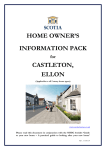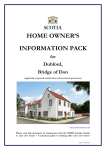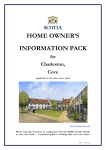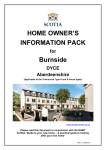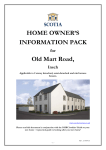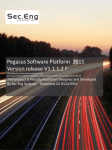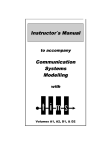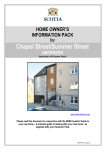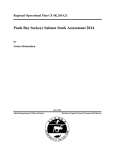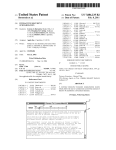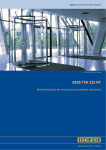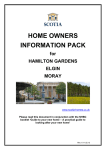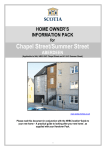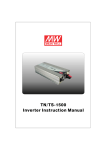Download File - Scotia Homes
Transcript
HOME OWNER’S INFORMATION PACK for DUBFORD, BRIDGE OF DON (Applicable to ground, first and second floor flats) www.scotia-homes.co.uk Please read this document in conjunction with the NHBC booklet ‘Guide to your new home – A practical guide to looking after your new home’ Rev. 1 10.03.15 Contents Page GENERAL MAINTENANCE AND SAFETY ______________________________ 4 OPERATING INSTRUCTIONS FOR GAS-FIRED CENTRAL HEATING AND HOT WATER SYSTEM _________________________________________________ 4 HOMESERVE EMERGENCY COVER ___________________________________ 7 RADIATOR SAFETY PRECAUTIONS AND RADIATOR NOTES ____________ 8 HEATING AND HOT WATER INSTALLATION __________________________ 9 GAS SYSTEM __________________________________________________________ 9 HOT AND COLD WATER SERVICES ___________________________________ 10 KITCHENS ___________________________________________________________ 11 EXTRACTOR FANS (DMEV SYSTEM) __________________________________ 12 VENTILATION AND AVOIDING CONDENSATION _____________________ 12 COMMUNAL DIGITAL TELEVISION AND SATELLITE INSTALLATION __ 13 TELEPHONE INSTALLATION ________________________________________ 13 WINDOWS ___________________________________________________________ 14 OPERATING INSTRUCTIONS FOR THE ELECTRICAL INSTALLATION__ 17 IF AN ELECTRICAL CIRCUIT FAILS ___________________________________ 18 SMOKE, HEAT & CARBON MONOXIDE DETECTORS/ ALARMS _________ 18 DOOR ENTRY SYSTEM _______________________________________________ 19 FLAT ENTRY DOORS ________________________________________________ 20 INTERNAL DOORS __________________________________________________ 21 FIRE RATED INTERNAL DOORS _____________________________________ 21 WALL TILING _______________________________________________________ 23 -2- SHOWER WALL PANELLING (WHERE FITTED) _______________________ 23 INTERNAL DRAINAGE _______________________________________________ 24 FLOOR FINISHES ____________________________________________________ 24 ROOF SPACE (WHERE APPLICABLE) __________________________________ 25 CONSTRUCTION OF WALLS, PARTITIONS, FLOORS & CEILINGS _______ 26 FIXING TO WALLS, CEILINGS OR FLOORS – IMPORTANT NOTICE _____ 28 EXTERNAL FIXINGS _________________________________________________ 28 COMMUNAL STAIRWELL ____________________________________________ 28 COMMUNAL PARKING _______________________________________________ 29 MOCK CHIMNEYS ___________________________________________________ 29 MOCK TABLING _____________________________________________________ 29 EFFLORESCENCE ___________________________________________________ 30 EXTERNAL AREAS ___________________________________________________ 30 RADON MEMBRANE _________________________________________________ 31 SURFACE AND RAIN WATER DRAINAGE CONSIDERATIONS ___________ 31 METERS ____________________________________________________________ 32 LOCAL AUTHORITY REFUSE AND RECYCLING COLLECTION _________ 32 COUNCIL TAX _______________________________________________________ 32 BUS SERVICE ________________________________________________________ 33 SCHEDULE OF TEST CERTIFICATES _________________________________ 34 NOTE: The information contained in this document is for our standard flat types and may not cover specific variations requested by you. -3- GENERAL MAINTENANCE AND SAFETY You are responsible for the regular maintenance and repair of your flat internal finishes, services, fittings and fixtures (the scheme manager or ‘factor’ will arrange maintenance and, if necessary, any repair of external areas such as the roof, external walls and also communal areas such as the stairwell and car parking, where applicable - all as described in the Deed of Conditions). Please take the time to read over the following general comments regarding maintenance work which are applicable to any internal work you may undertake to your flat. Regular maintenance work is required for all homes to keep them at their best in the years to come and to ensure that they continue to be a safe home environment. We recommend that you employ competent tradesmen/contractors to carry out the maintenance work, however if you decide to carry out maintenance work on your home yourself, then there follows a list of some of the basic rules to bear in mind; Always plan the job thoroughly in advance. Consider any risks - is there adequate ventilation? Do you need any safety equipment? Can the job be done another way to make it safer? If you are in doubt then do not attempt the job yourself – seek advice from a professional or employ a skilled tradesman or contractor. Check any materials you are going to use for any warnings or precautions and heed the material safety recommendations. Always use the right tools for the job and use them in accordance with their instructions. If you intend to work at height please be aware of the risks involved. Try to avoid working at height if at all possible but if you decide it is necessary then please make sure your ladder or stepladder is in good condition and securely held in place. There is a large amount of information and recommendations available on the subject of working at height on the internet or in most public libraries – take the time to familiarise yourself with the risks and recommendations involved in working at height before carrying out the job. If there is risk involved, try and avoid working alone. Dispose of any surplus materials and waste according to the manufacturer’s instructions, adherence to Local Authority waste regulations, and consideration for the environment. Always keep a well stocked first aid kit. Please also refer to your NHBC ‘Guide to Your New Home’ for more information on maintenance. OPERATING INSTRUCTIONS FOR GAS-FIRED CENTRAL HEATING AND HOT WATER SYSTEM Introduction Your flat has been fitted with a gas-fired heating system serving radiators and also providing a domestic hot water supply. -4- The gas–fired boiler is located in a hall cupboard or cupboard off the en-suite bathroom (depending on the flat type) and you will find the operating and maintenance instructions for the boiler in your handover pack. If, after referring to the user information on boiler controls in the boiler instruction manual, you are unable to find the answers to any boiler problems and the problem is an emergency which has arisen during the first 24 months after your legal date of entry to the house, then please contact HomeServe (please see section on HomeServe below for more details). If the fault is not an emergency (as described in the HomeServe cover summary) then please contact Scotia during normal office hours. You are responsible for the annual maintenance and servicing of the boiler, this should be arranged through any reputable, Gas Safe registered, plumbing and heating contractor. Heating and Domestic Hot Water Controls The system has the following controls:1. Boiler isolating switch. 2. Programmable Room Thermostat 3. Thermostatic radiator valves to radiators (except on the by pass radiator/s) 1. Boiler Isolating Switch This switch will be found on the wall in the boiler cupboard. This switch is to isolate the electrical supply to the boiler and should be left on at all times. Only use this switch if a fault develops on the boiler. 2. Programmable Room Thermostat Your flat has a programmable room thermostat located typically in the hall or in the kitchen/living room area or in the boiler cupboard and linked to a remote sensor located in the hall (location depends on your flat type). Examples of typical programmable room thermostats (the picture on the left shows a Danfoss TP7001 programmable room thermostat and the picture on the right shows a Danfoss TP9000 programmable room thermostat - the model installed may vary depending on your flat type); Drawing of a typical remote temperature sensor (linked to the programmable room thermostat); -5- The programmable room thermostat controls the boiler, telling it when you require central heating and hot water. The programmer has the facility to give several on/off times. Temperatures can also be selected for each on/off time. When the heating is selected on - the system will operate until the set temperature is achieved. Note that where the programmable room thermostat is linked to a remote temperature sensor then the temperature is measured at the remote temperature sensor location (not at the programmable room thermostat location) . The remote temperature sensor should not be covered or otherwise obstructed as this may impair its ability to accurately measure the temperature. When the system is selected off, the boiler will not operate unless the temperature in the hallway drops below the minimum setback temperature selected. You can select your minimum desired temperature, normally this can be set between 12 and 16°C. Please refer to the manufacturer’s instructions in your handover pack for the programmable room thermostat for further instructions. 3. Thermostatic Radiator Valves Thermostatic Radiator Valves (TRV’s) are fitted for comfort control i.e. 1 – low level heat, 5 – maximum level heat. They are fitted to all radiators except radiators located where there is a room thermostat sensor. They are essential to the full efficiency of your heating system and allow you to lower temperatures in unoccupied rooms thus reducing heating costs. TRV’s sense room temperature changes in individual rooms and adjust the flow of heated water through the radiators to maintain the desired temperature. Depending on level of comfort required, 2 – 3 should be selected. Please refer to the manufacturer’s instructions in your Handover Pack for full details. Picture showing a typical Thermostatic radiator valve, Note- the type fitted in your home may vary. Central Heating Should your central heating or hot water fail to work, please ensure that all of the procedures laid out in the boiler manufacturer's literature are followed. Failure to do this may result in a charge being made for an unnecessary call out. Bleeding of Radiators This should not be required with a sealed system. However, radiators feeling warm at the bottom but cold at the top would indicate air in the radiator. There are airing points normally at the top of the radiator. Use an air-bleeding key to turn clockwise to reduce air. You can do this by inserting the key and turning it anti-clockwise, then once the air stops a small amount of water will be discharged, quickly turn the key clockwise to tighten. Check pressure gauge on boiler, if it is below that recommended in the manufacturer's instructions, then it will be necessary to top up the system. See enclosed boiler user guide for full instructions. -6- HOMESERVE EMERGENCY COVER Your flat is covered under HomeServe’s Home Emergency Assistance Cover for a period of 24 months from your legal date of entry. This service provides emergency cover for your heating system in the event of a loss of central heating or hot water - providing the equipment has been maintained and serviced in accordance with the manufacturer’s instructions. It also extends to blocked drains, burst pipes (within your flat) and damaged window and door locks where there is a risk to security. Examples of what is/ is not covered are shown in the list below- please note that some of these examples may not apply to your own property. In an emergency situation (as defined in the Cover Summary as provided to you direct by HomeServe) where any of the above is affected you should contact HomeServe directly instead of Scotia. At the time of writing, the emergency contact numbers for HomeServe are 0800 694 4167 from a landline or 0330 1230179 from a mobile phone. Where any problem is not classed as an emergency by HomeServe you should contact the Scotia customer care department during normal office hours. Note that any problems in communal stairwell and external areas should be reported to the factor / scheme manager. Examples of what is covered/ not covered; Examples of what is covered Examples of what is not covered Internal Plumbing & Drainage Showers including the shower unit, controls, outlet or shower head Repairs to your internal plumbing and drains including where there is a loss of water to your property, blocked drainage and leaks Replacement of water tanks/radiators, thermostatic radiator valves, hot water cylinders and sanitary ware Clearing blocked toilets and waste pipes External Drainage Shared drains Clearing total blockages to your drainage pipes External guttering, rainwater downpipes, rainwater drains and soakaways Repair of a collapsed external drain Electrical Emergency & Breakdown All non-permanent wiring/electrics, e.g. kettles, fairy lights or any other and appliances with plugs An emergency caused by, or breakdown of, the domestic electrical wiring supply system, including permanent damage caused by a power cut Shower unit or immersion heater unit Security Doors (and windows) which do not secure your property, such as internal porch doors, internal doors and internal conservatory doors Making your property secure in the event of broken locks for external windows and doors that are your responsibility Failure of breakdown of the external locking mechanisms to doors or windows for outbuildings or a garage Gas Central Heating Breakdown A leak within or breakdown of the ‘natural gas’ gas central heating boiler, the central heating system and its associated pipework Drain down and isolate leaking water tanks, radiators Boilers which have been declared beyond economical repair (i.e. if the cost of parts incl. VAT is more than 85% of the retail price of the boiler) Repairs if we have advised you to carry out maintenance work to prevent a future breakdown (until that work is complete) -7- and hot water cylinders If you suffer a gas leak, you should first call the National Grid Emergency Service immediately on 0800 111 999 Electrical Heating Breakdown Repairs or replacement of the part(s) of the heater or replacement heaters. Oil Fired Central Heating Breakdown A breakdown of the boiler and/or system Drain down and isolate leaking water tanks, radiators and hot water cylinders Repairs, where due to obsolete parts, we can no longer cover you (the policy will continue without boiler cover until the boiler is replaced) Any repair to heaters which are beyond economical repair (if the cost of parts incl. VAT, is more than 85% of the retail price of the heater) Heated towel rails, infra red heaters, electric fires, skirting or kick-space floor heaters Boilers which have been declared beyond economical repair (i.e. if the cost of parts incl. VAT is more than 85% of the retail price of the boiler) Repairs if we have advised you to carry out maintenance work to prevent a future breakdown (until that work is complete) Repairs, where due to obsolete parts, we can no longer effect a repair RADIATOR SAFETY PRECAUTIONS AND RADIATOR NOTES Users should ensure that those who may come into close proximity to hot radiators are aware of the risks of burns. Users should take any necessary steps to minimise the risks of burns from hot radiators (for example where there are very young children in the room). Where applicable, consideration should be given to placing guards in front of the radiators or reducing the temperature of individual radiators by turning the thermostatic radiator valve to a low setting. Radiators are heavy items and are securely fastened to the wall on installation, with appropriate fasteners to secure the radiator bracket and suit the construction of the wall. Decorative covers (such as the decorative perforated MDF or timber covers that you can purchase from DIY stores) will significantly reduce the output of a radiator and thermostatic radiator valves should not be fitted inside these radiator covers (as this will stop the valves from working efficiently). These covers are not recommended as they will, by consequence, impede an individual room’s heat requirement, which your new heating system has been carefully designed to provide. The only exception to this would be the comments above regarding safety of young children. If you do need to fit a radiator cover for this purpose then you should use one of the metal mesh type covers, similar to a fire place guard, which will not impede the flow of heat from your radiator into the room. Radiators should not normally be used for the mounting of clothes airers, cat beds or other such fixtures. The mounting brackets of the radiator are designed to support the weight of the radiator itself and water contents, allowing for an adequate safety margin, and additional weight may compromise this margin and cause risk of failure, leaks and potential hot water burns. Appropriate facilities are required by Building Regulations for internal and/or external drying facilities and these are provided (please see “Ventilation and avoiding condensation”). Radiatormounted airers and other devices may lead to excessive internal moisture and any chips/damage -8- caused to the radiator itself may compromise the protective coating and potentially lead to corrosion/failure, which may not be covered by warranties. Note regarding curtains – Heavy curtains or lined curtains drawn over the windows are an effective way of reducing any heat loss through the windows during the autumn and winter months. The sooner you draw the curtains in the evening the more heat you will save. However, please note that if there is a radiator located below the window, and the curtains are too long and cover the radiator then much of the heat generated by the radiators will not find its way into the room and will instead be wasted out the window. Curtains covering the thermostatic radiator valves will also interfere with the operation of the valves. HEATING AND HOT WATER INSTALLATION Heating and hot water are provided by an Alpha InTec 34C wall mounted, high efficiency boiler with a gas saver flue gas heat recovery unit. Also a 50 litre thermal store may also have been installed (this depends on the flat type). Please note that to obtain the maximum performance and efficiency benefits the gas saver flue (and thermal store, where fitted) must be switched on. Turning off the gas saver flue will mean you lose efficiency benefits. Turning off the thermal store (where fitted) will mean you lose efficiency benefits and the volume of hot water available to you will be significantly reduced. A copy of the user manual, installation & service instructions, inspection, commissioning and service record logbooks for the system are enclosed with your handover pack. An annual gas service of the boiler and inspection/maintenance of the associated equipment, in accordance with the above instructions, is required to be carried out by GasSafe registered personnel. Failure to carry this out will invalidate the manufacturer’s and NHBC warranties. Note for flats with boilers located in an internal cupboard– flats which have the boilers fixed to an internal partition (such as a flat type 13) will have a flue running from the boiler through the flat at high level to the outside (typically the flue runs above an adjacent bedroom wardrobe). Where this is applicable, a demountable panel or access hatches have been installed in the ceiling of the wardrobe below the flue to allow access to the flue for future maintenance and inspection purposes. During the annual boiler service your heating engineer may require access to this flue through this demountable panel or access hatches. This note does not apply where boilers are hung on an external wall and the boiler flue goes straight through the wall to the outside or where boiler flues exit straight through a roof space. Note for top floor flats with boiler flues routed through the attic space – during the annual boiler service your heating engineer may require access to the flue in the attic space for inspection purposes. Access to the attic space has been provided via an access hatch through the ceiling – please refer to the ‘roof space’ section for more information. GAS SYSTEM Never obstruct gas boiler flue outlets or any ventilation, if provided, to the boiler. Never tamper with the gas installation or equipment. Any alterations to the gas supply pipework or work in connection with any gas appliance should only be carried out by GasSafe registered personnel. -9- You are responsible for the annual maintenance and servicing of all gas appliances such as the gas boiler, oven or hob (as applicable to your flat), this should be arranged through any reputable, Gas Safe registered, plumbing and heating contractor. If you suspect a gas leak: 1. Extinguish all naked flames. 2. Do not use any electrical switches or appliances 3. Turn off the gas at the meter. Where your gas meter is located inside your flat the gas shut off is the red lever next to the gas meter. Alternatively where your gas meter is located externally you will find the shut off lever inside the brown coloured box outside). Please make sure you know exactly where your gas shut off point is located in case you need to shut it off in an emergency. 4. Open all doors and windows. 5. Call the National Gas Emergency Service on its emergency number which is in the telephone directory under ‘GAS, Gas Emergency’. There is no call-out charge. The current emergency number at date of preparation of this document is 0800 111999. This service operates 24 hours a day and 365 days a year. HOT AND COLD WATER SERVICES Mains Cold Water Service The stopcock (shut off valve) for your flats incoming cold water service is located typically in the hall cupboard next to your flat entry door (stopcock is located at low level). If you need to shut off the water to your flat this is the stop valve you should use. There is also a shut off valve located within the service riser in the communal stair which can be used to shut off the water to your flat (this can only be accessed by the factor, in case of an emergency). Finally, there is an underground shut off valve located in an underground box in the public footpath usually to the front of the block of flats (the external shut off valves typically shuts off the water to 3 flats – so these are for use by Scottish Water). Domestic Hot Water The Alpha Intec 34C boiler produces domestic hot water in an energy efficient manner and the operation of this is fully explained in the enclosed Instruction Manuals. Please also refer to the notes in the Heating and Hot Water Installation section above. Sanitary Ware/Taps Sanitary ware should be cleaned in accordance with the manufacturer's instructions which are enclosed in your Handover Pack. The following are some important points to remember when cleaning your sanitary ware; The bath should always be cleaned immediately after use, preferably while the water is running out and the bath is still warm. Hot soapy water with a cloth should be used and the bath wiped dry. - 10 - Never allow solvents such as dry cleaning agents or paint strippers to come into contact with an acrylic bath. Never use gritty or abrasive cleaners on the sanitary ware which can cause scratches and other damage. Please note that WC cistern valves should be checked periodically and maintained as described in the manufacturer’s instructions contained in your hand over pack. We recommend that if you contact a plumber if you suspect that a WC valve has developed a fault. The manufacturer of the bath (where fitted) recommends the use of an anti slip mat when a shower is installed over the bath. Thermostatic mixing valve (where there is a bath installed) A thermostatic mixing valve to limit the hot water temperature at the bath tap to a maximum of 46°C is fitted below the bath. The thermostatic mixing valve manufacturer’s instructions recommended that you arrange for initial temperature checks to be carried out six weeks after occupation of the property, and then for an annual check to be carried out. This is to test the water temperature from the tap to make sure that the mixing valve is operating properly and to ensure the maximum limit of 46°C is not exceeded. Hot Water Temperature (kitchen sinks and wash hand basins) The hot water from your kitchen sink taps and wash hand basins can be very hot depending upon the boiler settings. The hot water can initially have a low temperature as cooler water sitting in the pipes is discharged but can then become hot suddenly. Appropriate care should be taken to avoid risks of scalding. KITCHENS Kitchen Appliances, Sink Units and Worktops Refer to the manufacturer’s instructions for operating and cleaning of kitchen appliances, sinks, units and worktops, these are enclosed in your Handover Pack. Cooker Hood (if applicable to your flat) – Please note that the kitchen cooker hood has been installed for use in the recirculation mode and a charcoal filter set has been fitted. The charcoal filters normally require changing after every three/four months or more frequently if used more than 3 hours a day. Replacement charcoal filters are available from on-line retailers. Also, please note that the metal grease filter should be cleaned at least once per month. As with all cooker hoods, there can be a fire hazard if the grease and charcoal filters are not cleaned and replaced as recommended in the manufacturer’s instructions. Please refer to the instruction manual for your cooker hood which is contained in your Handover Pack for more details, and for other important operating and maintenance information for your cooker hood. Connecting Appliances – (where applicable) Electrical connections for cookers and other electrical appliances requiring wiring work should be made by a qualified electrician using the pre-fitted wiring and fittings installed for this purpose. - 11 - When fitting a dishwasher or washing machine, please ensure the blanked end of the waste pipe tee piece has been removed. Note – this is not applicable where a ‘standing waste’ pipe has been provided. Please also ensure that the water supplies and wastes are securely connected to the pipework. Please also note that, where Scotia have not installed a washing machine but have left a space for one with a cold water supply adjacent to it, then the home owner is responsible for removal of the cap that has been fitted to the cold water washing machine valve – please ensure you remove this cap before making the water connection to your washing machine. Please also ensure that the appliance water supply and waste pipe is securely connected to the house pipework before turning the appliance on. EXTRACTOR FANS (dMEV SYSTEM) Greenwood Airvac Unity CV2GIP mechanical extract fans have been fitted in your flat. These are continuously running single point dMEV (decentralised Mechanical Extract Ventilation) fans with GIP (Guaranteed Installed Performance). The fans run continuously at a low (extremely quiet) speed and are automatically ‘boosted’ to a higher speed when required (the fans boost automatically using their humidity sensor). It is essential that the fans remain in operation at all times (unless switched off for maintenance) to maintain good air quality. Pictures of the Greenwood Airvac CV2GIP fan This is an energy efficient fan designed to provide an economical ventilation solution to the modern home. It utilises SMART Technology to control humidity and boost run on times to minimise the periods of time when it is running at its highest speed, minimising nuisance running noise and unnecessary energy wastage and heat loss typically associated with ‘traditional’ extract fans. More information on these ventilation fans can be found in the User/Homeowner Guide contained in your handover pack. Please read and comply with these instructions carefully to ensure their continuing smooth operation. VENTILATION AND AVOIDING CONDENSATION Condensation will be a problem in all new homes if adequate background heating and ventilation is not used. All new homes need ‘running-in’ and we recommend that you read carefully the section within the NHBC booklet: GUIDE TO YOUR NEW HOME, ‘Reducing Condensation’. Most windows are fitted with “trickle” ventilators at the top of the window. These can be opened or closed to allow more or less trickle ventilation. If you close the window trickle vents the dMEV fans described in the previous section will still continue to draw fresh air into your home, however, particularly during the ‘running-in’ period we recommend that they are left fully or partially open to maximise the fresh air entering your home. - 12 - The following are general guidelines for your information. To deal with condensation, take these two steps: 1. Produce less moisture Ordinary daily activities produce a lot of moisture very quickly. Cooking: To reduce the amount of moisture in the kitchen, cover pans and do not leave kettles boiling, open a window to allow excessive amounts of steam to be ventilated to the outside. Washing clothes: Put washing outdoors to dry if you can. Alternatively, please dry the washing in the bathroom (which is designed to accommodate drying clothes) with the door closed – the humidistat function of the extractor fan will remove the moist air to the outside (also if weather conditions permit – if there is a window in your bathroom it can be opened to help ventilate the moist air to the outside). If you have a tumble dryer, ventilate it to the outside (unless it is the self-condensing type). D.I.Y. kits are available for this. Drying clothes on radiator-mounted airers or on airers in rooms other than the bathroom may lead to excessive internal moisture. 2. Ventilate to remove moisture You can ventilate your home without making draughts. Some ventilation is required to expel the moisture, which is produced all the time, mostly just by normal breathing of occupants. Keep a small window ajar or a trickle ventilator open when someone is in the room. You need much more ventilation in the kitchen and bathroom during cooking, washing up, bathing and drying clothes. This means opening windows (where fitted) to assist in the ventilation of moisture to the outside and ensuring that the extractor fans are in full working order. Close the bathroom door when in use for drying clothes. This helps prevent the moisture reaching other rooms, especially bedrooms, which are often colder and more likely to get condensation. COMMUNAL DIGITAL TELEVISION AND SATELLITE INSTALLATION A television aerial socket has been provided within the Living Room area (specific room may depend on flat type, please refer to plans), to which a communal digital aerial and satellite signal will be fed. Your individual alterations may have requested additional points or a ‘returned’ signal to additional points in other rooms. Further information is provided in the Handover Pack. TELEPHONE INSTALLATION The main telephone point is located in the Living Room area (specific room may depend on apartment type, please refer to plans), it is compatible with any BT approved phone. - 13 - It is your responsibility to arrange connection to your chosen telephone service provider and arrange final connection of secondary socket wiring to main point. WINDOWS Your flat has white uPVC Sheerframe 8000 system (Nairn 8000) ‘Tilt + Turn’ inwards opening windows or ‘Reversible’ outwards opening windows, all manufactured and supplied by C. R. Smith of Dunfermline. The windows are fitted with lockable window handles to all ground floor windows and standard (non-locking) handles to all first and also typically to all second floor windows (lockable handles may have been fitted to second floor in some instances depending on the flat type). A key is supplied to operate the lockable handles and care should be taken to prevent damage to the handle by trying to force it open when lock is engaged. Important Notes for Tilt + Turn Windows - please note that the Tilt opening function is intended for general day to day use. The ‘turn’ opening function (where whole sash is opened into the room) is intended for cleaning and emergency escape purposes only. Care should be taken when using the ‘turn’ open function that the sash (or the trickle ventilator installed in the head of the sash) does not cause damage to the plasterboard window ingoes when fully open. The window should never be left unattended when open in the cleaning/escape ‘turn’ position. Important Notes for Reversible Windows – the reverse function (when it is opened beyond the initial safety restricted position and is turned fully around) is intended for cleaning the outside of the window and for emergency escape purposes only. Care should be taken when using the reversible function when cleaning the outside of the window- you should never lean out of the window to push it open- instead hold the top of the sash and pull it down. Note that the reversible windows should not be opened beyond the initial restrictor point or ‘reversed’ for cleaning in adverse weather conditions (high winds can cause the window to move unexpectedly resulting in damage to the window or injury to persons cleaning the window). For tall windows a suitable pole extension should be used for cleaning the glass. The window should never be left unattended when open beyond the initial safety restrictor position or when in the fully reversed position. For normal day to day ventilation purposes the reversible windows should be opened only as far as the initial restrictor allows. Notes on lockable handles - First floor window handles are non-locking (no removable key) to comply with the requirements of the Building Regulations in respect of emergency fire escape. Second Floor window handles may also be fitted as the non-locking type. However, please note that the Building Regulations recognise that individual home owners may want to fit additional locking mechanisms to first floor windows after they have moved in to their new home (for example where there are small children in the room) and if you wish to install any of the large variety of ‘child restrictor catches’ or any other additional locking mechanism that are available to your first (or second) floor windows then please note that they must be a ‘quick release’ type (without a key which might be lost) - a type which does not hinder escape through the window in the event of an emergency. The restrictor must also be suitable for the type of window and we also recommend that they are fitted by a skilled tradesman and that particular care is taken to ensure that they are fitted strictly in accordance with the restrictor catch manufacturer’s instructions. An incorrectly fitted additional locking mechanism can damage the window and lead to window guarantee problems. Advice can also be obtained from the window supplier (refer to the Schedule of Materials for contact information). Manufacturer’s Window Operating & Maintenance Guidance; Operation (PVCu Tilt & Turn Windows; - 14 - Your windows are designed to open in two ways. They can tilt inwards from the top to approximately 30º to provide ventilation, or turn inwards, like a door, for cleaning or emergency escape. To open your window to the tilt position, move the handle so that it is in the horizontal position. Pull the handle towards you. The window will tilt inward stopping at approximately 30º. To open your window like a door, move the handle to the vertical position then pull it towards you. To close your window, using the handle, push the window into the closed position. Maintaining light pressure on the handle, move it until the handle is pointing directly to the floor. Operation (PVCu Reversible Windows); To open the window from the closed position - raise the handle to the upright position to release the locking mechanism. The window can now be pushed open to the initial restricted position (approx. 100mm)- recommended for ‘day to day’ ventilation. If you require the window to be opened beyond the initial restricted position then the restrictor catch (located at the side inside the frame) should be pressed- this allows the window to be opened further. To fully reverse the window for cleaning of the outside push open the window to a safe arms length (without hanging out over the cill), take hold of the top of the window and pull down until the reverse restrictor is reached. To return the window to closed position the restrictor catch should be pressed and the window turned back around. When opening, closing and fully reversing the window please control the speed of the operation and take care to remove fingers from the restrictor catch area before moving the window. Remember if it is a windy day the window can move unexpectedly if it is not in one of the safety restricted settings. Maintenance To ensure the smooth operation of your windows you must carry out the following maintenance at least once per year (or more often where recommended): 1. Lubricate or oil all moving parts & locking points, using only clean and non-resinous grease or oil. 2. Check all components for looseness or wear. If necessary, tighten fixing screws. 3. Only clean your windows with a mild, neutral pH, diluted detergent. Avoid using solvent based or acid based detergents or abrasive cleaners as these will damage the uPVC frames and glass. Never use aggressive, acid based detergents or scouring powder on the handles or hardware because they can damage the protective surface of your hardware. uPVC frames should be cleaned every 3 months with a soap and water solution. A non abrasive proprietary cleaner suitable for plastic may be used for more stubborn blemishes following the manufacturer’s instructions. - 15 - Glass may be cleaned with either a proprietary household glass cleaner (following the manufacturer’s instructions) or a mild, neutral pH, diluted detergent. Glass can be easily scratched, therefore ensure heavy grime or dirt is removed carefully using soapy water. 4. After cleaning the hardware, surface treat with a silicon and corrosion free (i.e. non-acidic) oil, e.g. sewing machine oil. Please refer to the C R Smith ‘Window & Door Operating & Maintenance Guidance’ (contained within your Handover Pack) for more information including recommendations on lubricating and general maintenance. Notes regarding glass coatings: To comply with current building regulations all double glazed units installed in your home will have a low emissivity coating. Low emissivity (Low-e) glazing is a vital component of an energy efficient window. It has a surface coating that allows short wavelength heat from the winter sun to enter your home through the glazing, while reflecting back into the room the long wavelength heating produced by your heating system. This reduces heating costs and minimises internal condensation. Please note that this Low-e coating has considerable advantages but you should be aware that there are some minor features, due to the coating of the glass, which you can see in some or all of the following ways; • As a tint in the glass • As a ‘haze’ when viewing through the glass at some angles and in some lighting conditions • By the appearance of condensation on the outside of the glass under certain weather conditions (which is positive proof that the glass is preventing heat loss from your house) • There may be minor blemishes visible arising from the coating process and the tint may also change between individual double glazed units if the units are made from different batches of glass. These are not detrimental to the functioning of the unit and are not a defect. Please note that if you are replacing any of your double glazed units in the future you should ensure that your glazier uses low emissivity glass in your windows. Note regarding glass specifications: In addition to the note regarding Low-e coatings above, you should also be aware that certain windows may have either laminated or toughened safety glass installed. This ‘safety glazing’ is installed to comply with the Building Regulations. Also, some of the windows have acoustic rated double glazed units fitted (to bedrooms and in some cases living rooms). The acoustic glazing has been installed to comply with the Planning/ Building regulations. Any future replacement glazing units should be to the same specifications as originally fitted. Any competent glazier will be able to identify the glazing specification used and you should ensure that lower specifications are not used. It should also be noted that windows with safety or acoustic glazing have characteristics inherent to the nature of the product and its production process. Specifically you may find that the windows fitted with safety and/or acoustic glass are heavier and when closing them from the ‘tilt’ position (for Tilt + turn windows) you may have to use both hands, placing one on the handle and the other on the window frame. Also when operating the reversible windows greater care must be taken for those fitted with heavier acoustic and/or safety glass. - 16 - In addition to weight considerations, while all double glazed units use ‘processed glass’ (and are subject to an amount of imperfections occurring during the manufacturing process), safety and acoustic glass is more prone to these minor visual imperfections. An example of this is that when toughened safety glass is being manufactured it is heated to extremely high temperatures, creating micro-tears which on cooling add strength to the glass. This process can result in small imperfections or visual distortions forming on and in the glass- these are not usually noticeable under normal viewing conditions but may be evident under close inspection. They are, however, an acceptable characteristic of the finished product and are not recognised as a defect in the glass itself. Laminated glass, which is manufactured from several layers, has similar characteristics and it can also be subject to minor blemishes and imperfections which is an unavoidable consequence of the manufacturing process and is not a defect. Important Safety Notes-Maintenance and Cleaning; Care should be taken when opening and closing your windows for cleaning and maintenancenever lean out of the window or stand on a chair or other possibly unstable platform to reach the top of the window – use a suitable pole extension when cleaning the glass and window as shown in the diagram below. The window should never be left unattended when in the fully open ‘turn’ (for Tilt + turn windows) or fully reversed (for reversible windows) position. OPERATING INSTRUCTIONS FOR THE ELECTRICAL INSTALLATION The Consumer Control unit for your flat is located in a hall cupboard. It contains a labelled main isolator, RCDs and circuit breakers or “trip switches”. The consumer control unit is a device that controls the electricity supply to your home, splitting the incoming electric supply into various electrical circuits around your home. The consumer control unit contains the Mains Switch, RCBOs (Residential Current circuit Breaker with Overload protection), RCD’s (Residual Current Devices) and MCBs (Miniature Circuit Breakers). The main switch is normally ‘ON’. In order to isolate all supplies, switch to ‘OFF’. There are typically two RCDs in your consumer unit. Each RCD protects a section of the consumer unit. They are designed to ‘trip’ when there is an electrical leakage to earth thereby giving protection to personnel. An RCD would normally trip before an MCB. - 17 - These circuit breakers and RCDs are all designed to trip if there is a fault in a circuit, or if a faulty appliance is switched on. This helps to prevent serious accidents that may result in damage and injury. Under fault conditions these will be in the ‘tripped position’. IF AN ELECTRICAL CIRCUIT FAILS A circuit may trip OFF. If this happens, you should follow the procedure set out below. 1. Check with the aid of a torch whether the RCD (mid position) or MCB (fully down) is in the OFF position. 2. Switch RCD (press down then push to the fully up position) or MCB to ON position. 3. If the RCD does not re-set, switch off all the MCBs, re-set the RCD then switch on each MCB individually until the faulty circuit is identified. 4. To identify the cause of the fault switch off all appliances in that circuit, re-set the RCD and MCB, then switch back on each appliance until the defective appliance is found. Over-filling kettles, irons etc. can cause this type of fault. N.B. It is important to ensure that the bulbs used in light fittings do not exceed the rating for that fitting. NOTE: Electricity is dangerous and can kill. If you are unsure of any aspect of your electrical installation, please consult a qualified electrical contractor. SMOKE, HEAT & CARBON MONOXIDE DETECTORS/ ALARMS Your flat is fitted with a smoke detector located in the hall (and in some flats also in the living room), a heat detector (located in the kitchen area) and a CO (Carbon Monoxide) detector which is typically located in either the hall or in the main bedroom (depending on the flat type). These alarms are mains operated with battery back up and connected to bedroom lighting circuits. The smoke detectors are extremely sensitive to smoke and dust particles of any kind and can be activated by the likes of burning toast. The heat detector in the kitchen is less likely to cause ‘false alarm’ problems as it is not responsive to any type of smoke or fumes, only heat such as generated by a chip pan type fire (but not from smoke caused by burning toast or similar). The CO detector monitors Carbon Monoxide levels and its alarm will activate if safe levels are exceeded. You must read and fully familiarise yourself with the instructions for the smoke, heat and CO detectors. Copies of the instructions are contained in your hand over pack and are also available for downloading from the manufacturer’s website - the instructions contain vital information on the operation and maintenance of your detectors. If any of the smoke detectors are activated you should check the property and, if no reason for its activation is found, it could be a nuisance alarm caused by cooking smoke reaching one of your smoke detectors or something similar. If this occurs, open a window to clear the smoke or dust and the alarm will cease and test/ maintain the detector as described in its instructions. - 18 - If the heat detector activates you should follow the advice contained in the heat detector instructions. If the CO alarm activates please carry out the instructions contained in your carbon monoxide alarm instructions. Depending on the type of CO alarm fitted these instructions typically include the following - ventilate the area, turn off appliances, evacuate the property, get medical help for anyone suffering from the effects of CO poisoning, ring your gas supplier or other supplier on their emergency number, do not re-enter the property until the alarm has stopped (if the alarm has been silenced by pressing the Test/Hush button, wait at least 5 minutes to allow the alarm to check that the CO has cleared). Do not use the fuel burning appliance(s) again until they have been checked by an expert. In the case of gas appliances this must be a Registered Gas Installer. To reset or to test the smoke, heat and CO detectors follow the manufacturer’s instructions as enclosed in your Handover Pack. The back up batteries should be changed as recommended by the manufacturer and an intermittent beep normally indicates that the battery needs to be replaced. The CO detector sensor module typically must be replaced after 5 years of operation (refer to its instructions). DOOR ENTRY SYSTEM Maintenance of door entry system- the door entry system will be maintained by the scheme manager (factor). If a fault is found or suspected in the door entry system please report it to the scheme manager. Operating instructions for the door entry handset- When a visitor pushes your flat number on the door entry panel (located on the outside wall beside the front and rear stairwell access doors) your handset will ‘ring’. To speak to the visitor lift the handset and this will connect you to the door entry panel. If you wish to let them into the stairwell press the button marked with a key during your call- which will release the lock on the stairwell entrance door. Further instructions are contained within your hand over pack. Please note that the second button on your handset (the lower button) does not have a function. Also note that when someone pushes your flat number button on the outside panel the ‘ring’ comes out of your handset ear piece- do not hold the hook down while holding the telephone to your ear because if someone pushed your flat number button on the external door entry panel your handset will ring loudly next to your ear. Typical door entry system handset; Extract from manufacturer’s operating instructions for door entry system handset; - 19 - The service button on the door entry panels is to allow access for postmen and the like to your building during a set time period (typically 6.30am to 11.30am) to make deliveries. When the service button is pushed on the panel at the front door between the set times it will automatically open the door. Power failure- in the event of a power failure the front door will automatically unlock (this is to ensure that access for the fire brigade or other emergency services is maintained if the door entry system is not working due to a power failure). FLAT ENTRY DOORS Your flat has been fitted with a Jeld-Wen Arlington flat entrance door-set with a Briton overhead heavy duty door closer. This flat entrance door-set provides fire protection and security and it should be regularly checked to ensure it functions properly and its various components are in good working order. We recommend that periodic checks should be carried out at least once every three months. Also, during the first year after occupying a newly built flat you should check its operation more frequently. The door-set components such as the letter-plate (where fitted), hinges, handle/ lock should all be checked. Also the door leaf should be checked to make sure no unequal gaps have formed between the door leaf and the door frame. If any defect is found then repairs should be carried out as soon as possible. Any slight alteration or defect to the door or its surroundings can affect the performance of the door and can result in it not performing as well as it should. Please also note that the integral acoustic, smoke and intumescent fire seals (recessed into the door side and top frames) have seals to protect from smoke. The seals must not be over-painted as this reduces their effectiveness. Also, the letter-plates (where fitted) are fire rated- if you are replacing the letter-plate (or any other of the door components) in the future, then ‘like for like’ specifications should be used. Operating and Maintenance Notes for the Door-Set; Door operating instructions- to lock the flat entry door from the inside lift the handle (to activate the multi point locking) and return it to the horizontal then turn the thumb turn fully towards the locking side of the door. To open the door from the inside, turn the thumb-turn in the opposite direction and open the door using the handle. To lock the door from the outside lift the - 20 - handle and return it to the horizontal and turn key fully towards the locking side of the door. Open the door by turning key in opposite direction and using handle. NOTE - excessive force should not be required or used to lock or unlock the door. Copy of the manufacturer’s Door-set maintenance instructions; Notes for The Over-Head Door Closer; The door closer must not be disconnected or removed or otherwise restricted as its function is to ensure that the door closes by itself in order to maintain the fire security of the flat and communal stairwell. The operation of the door closer fitted to the flat entrance door should also be regularly checked. User maintenance of the door closer is to periodically apply light oil to the arm knuckle joints – any other maintenance work must be carried out by a qualified person (see below). The door closer can be checked by user by a visual inspection to make sure all components are securely fixed (no loose screws) and by opening the door fully and ensuring that it closes fully without binding or catching on flooring or the door frame. If you suspect that the door closer is faulty or requires adjustment do not attempt to repair it yourself- the closer has high internal pressures and under no circumstances should you attempt to dismantle the closer. If you suspect that it is faulty and in need of repair or replacement please contact a specialist experienced in installing and maintaining door closers- an experienced joiner for example. INTERNAL DOORS Handles should be cleaned with a soft non abrasive cloth and for stubborn stains mild soapy water may be used. Care should be taken to avoid scratching surface of handles. The mechanism of the handle should be lubricated once a year with a light oil. Hinges and latches/locks should be lubricated on a regular basis with WD40 or similar product. Please refer also to the Fire Rated Internal Doors section below. FIRE RATED INTERNAL DOORS In flats some of the internal doors are required to be fire rated to comply with building control requirements (30 minute fire resistance). These doors can be easily identified because they have door closers and fire/smoke seals fitted. - 21 - These fire rated doors are for your safety and are designed to give you time to safely leave the flat should a fire break out in one of the rooms. The door closers must not be disconnected or removed or otherwise restricted as their function is to ensure that the door closes by itself in order to maintain fire security for the occupants. Just as with any similar life saving product, a fire door should be regularly checked to ensure it functions properly and is ready to use. It is just as important as testing a smoke alarm or checking the pressure of a fire extinguisher. Most of the time a fire door is used like any other door and it is subject to the same day-to day wear and tear of opening and closing. It is important to check if this regular use has affected it in any way. Any slight alteration to the door or its surroundings can affect the performance of the door in an emergency and can result in it not performing as well as it should. It is therefore important that you inspect and maintain the fire doors regularly to ensure that everything is in working order. We recommend that periodic checks should be carried out at least once every six months and where the door is heavily used it should be checked at least every three months. Also, during the first year after occupying a newly built home you should check the fire doors more frequently. The integral smoke and intumescent fire seals (recessed into the door side and top frames) have brush seals to protect from smoke. The brush seals must not be over-painted as this reduces their effectiveness. Typical intumescent smoke and fire seal (they are available in different sizes and colours- the type fitted to your home will depend on the particular flat type); The operation of the door closer, the integrity of the fire and smoke seals and all ironmongery fitted to the door should be checked periodically and repaired if any defect is found. Picture of a typical door closer – this shows a Geze TS1500 over head door closer with optional polished stainless steel cover(the type may vary depending on the flat type and door closer location within the flat); The door closer can be checked by opening the door fully and then checking that it closes fully by itself without binding or catching on flooring or the door frame. Note – if you suspect that the door closer is faulty please do not attempt to repair it yourself- the closers have high internal pressures and under no circumstances should you attempt to dismantle the closer. If you suspect that it is faulty and in need of replacement please contact a specialist experienced in installing and maintaining door closers- an experienced joiner for example. - 22 - The following is an extract from the Geze TS1500 overhead door closer instructions (a typical over head door closer) for your information; Hinges should be checked to make sure there is no visible wear. Latches and handles should also be checked to ensure that they are not loose and are working correctly. If replacing any of the fire rated internal door leafs in the future, a door which has a FD30 fire door rating and fire-rated ‘like for like’ ironmongery components must be used. Any replacement doors must also be fitted with a suitable self closing mechanism (such as the door closers currently fitted) and fire/smoke seals. WALL TILING Wall tiles and in particular the grout between tiles should be regularly cleaned using a proprietary tile/grout cleaner in accordance with the manufacturer’s instructions. Grout should be inspected and any areas which become loose should be replaced. The sealant between the wall tiling and any worktops should be inspected and replaced as necessary. SHOWER WALL PANELLING (WHERE FITTED) Laminate wall panelling (where fitted) should be cleaned by using hot water and a mild detergent applied with soft cloths or soft nylon brush. Non scratch cleaners may also be used. On no account should scouring pads, acid based toilet cleaners or limescale cleaners be used. Wall panelling and shower enclosure/tray should be dried off after use. Abrasive or aggressive cleaning products should not be used as they will damage the laminate surface of the panel. - 23 - The sealant around the base of the wall panel should be inspected and replaced as necessary to prevent water ingress between the shower tray and the panelling. INTERNAL DRAINAGE Soil and vent stacks run vertically through your flat and they serve all flats above and below you as applicable to the location of your flat. The soil stacks are hidden within plasterboard faced ducts and bulkheads and have access panels located at points where access may be required in the future if maintenance work is being carried out. Picture of a typical access panel; These access panels are recessed into the plasterboard and have a hinged fully removable door for easy and convenient access. They can be painted over, if required, during any future redecoration work that you may carry out. Please note that these access panels should not be removed or sealed up – they are there to allow fast access to rodding or drainage access points – access will be required if, for example, a blockage occurs in the soil pipe or during maintenance works. FLOOR FINISHES Please note that any wooden flooring or other feature flooring such as tiles or adhered ‘Karndean’ (or similar flooring) laid by you when you move into your home will not be lifted and re-laid as a result of any maintenance work which may require access under the floor. If maintenance work is required to any part of a floor or to any under-floor services we will require you to arrange the lifting and reinstatement of any feature flooring to allow us access. Notes regarding concrete floors (normally ground floors) – concrete floors in your home have been finished to the standard tolerances obtainable by the material. Before laying floor coverings such as vinyl or wooden overlay flooring to concrete floors you should be aware that some important steps should be taken by you; (1) You should have your floor covering installer check the moisture content of the concrete floor. This is particularly important if you are laying the floor covering immediately after moving into your home, as the concrete floor may still be drying out - 24 - and moisture can affect some flooring materials. If necessary you should allow the concrete floor to dry out sufficiently before laying any flooring which may be affected by moisture or the concrete floor should be treated in accordance with the flooring supplier’s recommendations before installing any vinyl or wooden or other feature type flooring. (2) Concrete floors will normally need a self levelling screed applied prior to laying any vinyl or overlay type floor covering, again in accordance with the floor covering installers recommendations. Notes regarding Chipboard Flooring - Chipboard flooring (normally to the first and second floors) should be prepared in accordance with manufacturer’s recommendations prior to fitting of vinyls, wooden overlays or ceramic floor tiles. Also note that chipboard flooring may have service ducts installed (sections of flooring which can be removed to allow access to pipes and other services). We have installed these ducts so that they are level with the adjacent floor – however it should be noted that, because timber floors naturally shrink as they dry, this drying out may result in minor differences in level between the duct cover and the surrounding floor. This may become evident with some types of thin floor coverings and your choice of floor coverings should take this possibility into account. ROOF SPACE (WHERE APPLICABLE) The attic space (applicable to top floor flats only) has not been designed to allow for storage. Do not use the attic space for storage. Flooring the roof space and using it for storage may cause deflection in the roof structure resulting in problems such as cracks appearing in your ceiling or damage to the roof structure. The attic has mineral wool insulation between and over ceiling joists. This insulation can cause skin irritation. If handling the insulation it is recommended that appropriate protective clothing and equipment be worn. Care should also be taken if entering the attic – the ceiling plasterboard between the joists will not support your weight and there may be service pipes, extract fan ducting and cables hidden by the insulation that you can damage by inadvertently stepping on them. An attic access hatch (also called a loft access door) has been provided through the ceiling of top floor flats and this is intended only to be used by tradesmen for attic space inspection or maintenance work. Note that if opening the loft access door it should be supported so that it does not swing down suddenly. Top floor flats may also have smaller inspection hatches located in the ceiling – these are to allow access for inspecting the boiler flue in the attic and are for your heating engineers use when carrying out the annual boiler service (note this is only applicable to some flat types). Operating instructions are normally to be found fixed to the inside of the ceiling loft access door- the following photograph shows a typical set of instructions; - 25 - It is advised that you do not enter the attic space. The attic access door should only be used by competent tradesmen for access to the attic for any essential maintenance works. CONSTRUCTION OF WALLS, PARTITIONS, FLOORS & CEILINGS The following notes provide, for your information, outline details of the construction for each part of your flat. This information is generalised and particular areas of your flat may differ. External walls: The external walls comprise a 100mm thick block-work outer leaf, 100mm wide cavity (with 50mm thick polyisocyanurate PIR partial fill cavity wall insulation boards) and 140mm thick concrete block-work inner leaf. The outside has drydash roughcast and the inside (flat side) has a further layer of 50mm thick polyisocyanurate (PIR) insulation installed to the inside of the block-work inner leaf, 50mm metal framing forming a service void and finished internally with 12.5mm thick vapourshield plasterboard linings which have been taped, filled and decorated. Safety Note – all external walls are load bearing and designed to achieve fire and acoustic building regulation requirements and must not be altered. Party Walls (Flats): Walls between your flat and adjoining neighbouring flat - where applicable. These walls comprise a 215mm thick solid block-work wall with sand cement render on both sides. Then, on both sides of the solid block-work wall there is 15mm thick acoustic plasterboard linings on 50mm metal framing forming a service void. One side also has a layer of 50mm thick sound absorbent insulation behind the metal framing. Safety Note – all party walls are load bearing and are constructed to a fire resistant/ acoustic specification – they must not be altered in any way. Party Walls (Flat to Stairwell): - 26 - Walls between your flat and the stairwell. These walls comprise a 215mm thick solid block-work wall with a coat of sand cement render. On the flat side a layer of 60mm thick polysiocyanurate (PIR) insulation is installed then a layer of 50mm thick sound absorbent insulation and 50mm thick metal framing and a layer of 15mm thick acoustic plasterboard, taped and filled and decorated. Safety Note – all party walls are load bearing and are constructed to a fire resistant/ acoustic specification – they must not be altered in any way. All partitions: 70mm thick metal framing forming partitions with 15mm thick acoustic plasterboard linings each side, taped, filled and decorated. Mineral wool acoustic insulation is fitted in the partitions to bedroom, bathroom and the like areas. SAFETY NOTE – some internal walls may be loadbearing. Do not remove or alter load bearing partitions, or make substantial alterations to them, without getting professional advice. Ground floors: Concrete floor slab on rigid insulation. The ground floor may also incorporate a radon membrane - located under the floor – please refer to the Section ‘Radon Membrane’ for more information. Floors (flat separating floors); Separating floors between ground and first (and first and second) floor flats comprise (from floor to ceiling below) 22mm thick chipboard flooring on an acoustic batten/saddle system with 25mm acoustic insulation installed between the battens, on 50mm minimum thickness sand / cement screed on 200mm thick precast concrete floor slabs. The ceiling under the precast concrete floor slabs comprises a metal framed suspended ceiling system (to form a service void) fixed to the underside of the concrete floor slabs and a layer of 12.5mm thick acoustic plasterboard, taped, filled and decorated. Safety note – all flat separating floors are load bearing and designed in accordance with the building regulations in respect of fire and acoustic requirements – the separating floors must not be altered in any way. Top floor Ceilings: Horizontal Ceilings; (top floor flats only) 12.5mm thick plasterboard fixed to the underside of the roof trusses with a 350mm thick layer of mineral wool insulation above. Insulated ceiling access hatches are installed where access for maintenance may be required in the future. Sloping Ceilings; (top floor flats only) 12.5mm thick vapourcheck plasterboard fixed to underside of rafters with 150mm thick PIR insulation board fitted between the rafters. Future alterations – should you consider making any alterations to your flat in the future such as altering the partition layout you should check relevant Local Authority permissions and/or use the services of a qualified architect before starting. The ground floors, external and party wall service voids, internal partitions, first and second floor voids, ceiling and attic space all have services such as pipes and cables installed in them – refer to the safety precautions below if installing any fixings into these parts of your home. Appropriate proprietary fixings should always be used to suit the wall construction (see below). - 27 - FIXING TO WALLS, CEILINGS OR FLOORS – IMPORTANT NOTICE Wall fixings (for pictures, mirrors etc.) must be of the appropriate type for the type of walls described above. Be very careful if nailing or drilling into walls, ceilings or floors to avoid contact with any pipes or electric cables which may lie hidden behind the surface. We recommend that you use a services detector (cable detector) before drilling or nailing – it can reduce the risk of serious injury. If using power tools to install a fixing, you should always use a R.C.D. (residual current device). You should also always check for pipes and cables before drilling or nailing into floors or ceilings. In addition to the above please note that fixings should never be made to the following wall areas:a) Directly above or below any electrical socket outlet, switch or appliance. b) Directly horizontal to any electrical socket outlet, switch or appliance. This is because electrical cables run in these areas. Note for any flat with under-floor heating (if applicable) - you should never drill or nail into any floor which has under-floor heating fitted. EXTERNAL FIXINGS Any external fixings should only be made with consideration to the Deed of Conditions. COMMUNAL STAIRWELL Please note the following points with regards to communal stairwell areas; 1. The stairwell is a fire escape route for you and your neighbouring flats. Please do not leave anything in the stairwell which could cause an obstruction or hazard to anyone exiting the building in an emergency. Keep the stairwell clean and tidy so that in any emergency it can be used safely. 2. The windows in the stairwell are non-locking as they have to be easily opened in an emergency by the fire brigade for use in clearing smoke. The windows should normally be kept closed. In addition the top floor window in the stairwell is fitted with a smoke venting system for use by fire brigade personnel only. This system allows fire brigade to open the top floor window by activating a ‘break glass unit’ which then uses a motor (actuator) to open the window. The system will be maintained by the factor. If the system is activated by a false alarm the factor should be contacted – only the factor can reset the system and close the top floor window. The following is a picture of a typical break glass unit for manual activation of the smoke vent systemfor the use of fire brigade personnel only; - 28 - Typical smoke vent actuator (electric motor) fitted to the top floor window – this device will be maintained by the factor- do not turn this off or attempt to unhook it from the window – it is part of the smoke venting system and may be required in an emergency; 3. The stairwell front and back doors are fitted with overhead door closers to ensure that the doors are self closing. This is for your safety and security- please do not disconnect or otherwise restrict the operation of these door closers or prop open the doors. Please ensure stairwell external doors are securely closed after use. 4. The stairwell services cupboard (on the ground floor under the stair), and also the stairwell service risers, contain services such as pipework, cables, mains electricity distribution boards, telephone apparatus and control panels for the door entry, TV, smoke venting and electrical systems and the like. Occupants of the flats should not attempt to open or enter service riser access hatches or the service cupboard - the equipment contained within can be dangerous. 5. Stairwell Lighting- the stairwell lighting includes emergency lighting (with battery back ups fitted). In the event of any loss of power these emergency lights will come on to allow the stairs to be used safely. PIR sensors operate the stairwell lights under normal circumstances. If you suspect that a fault has developed with the stairwell lighting please report it to the scheme manager (factor). 6. Please note that the power sockets in the stairwell are for maintenance personnel use only. COMMUNAL PARKING There is a car parking area located to the rear of your block of flats for your and your neighbours’ use. The Scheme Manager (factor) will allocate one of these spaces to you. Visitor spaces will also be available. The Scheme Manager will be responsible for the maintenance and repair of the car parking areas. MOCK CHIMNEYS Chimneys (if installed on your block) are lightweight GRP architectural features. They have been independently tested in respect of wind load resistance, hygrothermal test (extremes of heat/rain and freeze/thaw cycles) and water ingress and passed the strictest testing requirements. Note that the chimney is not designed to support additional loadings such as satellite dishes or TV aerials or other such apparatus. Do not attempt to install any fixings to the mock chimney. MOCK TABLING Where fitted, a lightweight composite GRP tabling (or coping) system manufactured by BuildLite of Sheffield has been installed on the roof. This system has been independently tested in respect of weather resistance and wind loadings. - 29 - Note that the lightweight tabling is not designed to support additional loadings. Do not install any fixings to the lightweight tabling. EFFLORESCENCE For your information - the appearance of a white deposit on external walls is caused by ‘efflorescence’. This is a consequence of drying out and can often occur after a new house is constructed and is drying out. It can also occur when a wall dries out after period of heavy rain or in the spring as a result of drying out after a wet winter. As well as external wall materials such as block-work and mortar joints, it can also occur on products such as precast window sills, driveway paviors and paving slabs and also internally on concrete floors and areas of similar construction. The efflorescence is caused by natural salts being drawn out of the wall materials while drying out and is quite normal. It is neither harmful nor detrimental to the performance of the material and, whilst it may look unsightly, the majority usually disappears over time. The advice given by most brick, block, cement and precast concrete manufacturers is that it is best dealt with by the combined effect of time and weather. If efflorescence occurs externally on your home it is our policy to follow this advice and allow it to disappear naturally. It will usually disappear within a few weeks, washed away by normal rainfall. This process may take some time to draw out and remove all of the natural salts causing the efflorescence however it should be apparent that each time the efflorescence appears it will be in decreasing amounts. If efflorescence occurs on internal concrete floors or other such areas then it can be removed by brushing with a non metallic brush and then removing the deposits with a vacuum cleaner. Internally occurring efflorescence should disappear quicker after brushing and vacuuming than external efflorescence as the home is dried out by the heating. Should persistent efflorescence occur internally which does not disappear after removing it by the methods described above, then please contact Scotia or the Scheme Manager/ Factor for further advice. EXTERNAL AREAS The external areas around the block of flats will be maintained by the scheme manager/ factor. However please read the following general notes which contain important points for your information relating to your use of the external areas. Manholes give access to the drains, usually where branches join together, do not obstruct or cover them with soil or large plant pots or the like. They may need to be accessed quickly if there is a blockage. Please note that there are live underground services cables in the ground around your house. Great care MUST be taken if digging or carrying out excavation work in the vicinity of live underground cable routes. Underground cables may be found just below the surface, although they are normally laid between 0.45m to 1.0m deep from the surface. Reduced depth may result from ground disturbance after laying or because the cable had to be laid over an underground obstruction. Even shallow excavations (e.g. for post holing and fencing work or for garden features such as ponds) may be a source of danger. If you do uncover a cable during excavation work - ALWAYS - 30 - assume it is live. If in any doubt contact a qualified person to seek advice before carrying out excavation work. External Areas (General Notes) Damage – Walking on turf before it has properly settled in can cause considerable damage. Dents and hollows made on new turf will not disappear and are often difficult to repair. It usually takes about a month to become firm enough to walk on, but this can vary according to weather and soil conditions. Damp Proof Courses – there are damp proof courses built into your external walls to prevent damp from the ground soaking up the outside walls. These are normally approximately 150mm from the ground level around your house. It is important that these damp proof courses are kept clear – if you are carrying out any landscaping or ground-works alongside your external walls then please ensure that you do not cover these damp proof courses or otherwise bridge them, allowing damp to rise up past the damp proof course. RADON MEMBRANE Applicable to ground floor flats- there may be a radon gas protection membrane under the concrete ground floor (depends on the location of your block of flats within the development). Should any work be carried out to the ground floors which would involve puncturing the radon membrane then it should be protected/ reinstated in accordance with the manufacturer’s instructions. SURFACE AND RAIN WATER DRAINAGE CONSIDERATIONS The scheme manager/ factor will maintain the surface and rain water drainage systems serving your flat, however there are some important points relating to the drainage that you should be aware of. Please read the following points: 1. Design Matters. We have designed the rainwater and parking drainage to comply with Local Authority Regulations (such as planning, building control and roads construction consent conditions) and SEPA (Scottish Environment Protection Agency) requirements including SUDS (Sustainable Urban Drainage Systems) requirements. In simplified terms these regulations require us to ensure that the drainage systems designed and installed around your block of flats collects any rainwater which falls onto your block and surrounding area and drains it away in a responsible manner. It is common for the regulations to require that the rainwater falling on your garden ground is attenuated within your plot boundary and encouraged to soak away into the surrounding ground rather than running off your plot into the local authority drainage system. This practice minimises the risk of the local authority drainage systems becoming over-loaded in periods of high rainfall therefore reducing the possibility of flooding. 2. Alterations to your garden/ landscaped ground. Removal of garden areas and installation of, for example, impermeable patio areas or areas of other hard standing will reduce the area of ground available to soak up rainwater and could lead to flooding problems if adequate additional drainage is not installed at the same time. Any alterations to the garden ground around your block should take this into account and reference should also be made to the Deed of Conditions. 3. Avoiding Blocked Drains. The foul drainage system from your flat is designed to take used water from sinks, showers, baths and toilet waste. The drainage is not designed to take inappropriate items such as wipes (baby, personal cleaning and the like), sanitary - 31 - items, cotton wool, cotton buds, disposable nappies, cooking fat or oil or grease and the like. Scottish Water, who maintain the drainage network in the streets, have to deal with on average 40,000 blocked drains every year across Scotland- blocked drains can lead to flooding of your property and your neighbouring properties. Around 80% of these blocked drains are caused by inappropriate items being put down the toilet or fat, oil or grease being put down the sink. Please ensure that you do not dispose of inappropriate items into your drainage system. Refer to the Scottish Water leaflet included in your hand over pack for more information. 4. Water Butts. If you intend to install a water butt to one or more of the rainwater downpipes please ensure that you also fit an over-flow back into the rainwater downpipe (to avoid the water butt over-flowing and causing flooding) and that any water butts are located in accordance with any relevant Deed of Conditions and where they will not cause an obstruction for other users. Kits for water butt overflows are available in any good garden centre. METERS The Electric meter for your flat is located in the cupboard located next to your flat entry door. The Gas meter is located in either an external semi-concealed ground meter box. LOCAL AUTHORITY REFUSE AND RECYCLING COLLECTION The development has been planned to incorporate the required storage stances for wheeled bins and routes for collection vehicles. Aberdeen Council has responsibility for refuse collection at Dubford, Bridge of Don and, at the time of writing, will provide appropriate bins to each plot on completion. It remains your responsibility for making these bins available for collection on the designated days in accordance with good practice and the Council’s policies and to ensure that your bins are stored in the designated fenced bin enclosure area when they are not awaiting collection. As your own property is within a block with communal access, the Local Authority may provide larger bins for this situation. It will be the collective responsibility of all residents within your block to ensure that these bins are made available for collection at a kerbside location on the designated day/s, along with their return to the rear communal bin store area after they have been emptied. The bins provided may include 1280 litre bin/s (1430mm long x 985mm deep x 1260mm wide approx) and a food recycling bin (including internal container and housing). Proper care and attention should be taken when handling these bins, for further information regarding operation and safe handling, please refer to Aberdeen Council’s guidelines. Should you have any queries or need advice regarding Waste and Recycling, perhaps for additional bins, advice on special collections or waste collection calendars in your area, please contact the Aberdeen Council Waste Team on 0845 6080919 or at [email protected] COUNCIL TAX The local authority will be aware of the new homes which are within your development, with a responsibility for payment of council tax falling upon the new owner (yourself). The authority - 32 - will have made a banding valuation for your own property type and will issue payment instructions and schedules accordingly. Should you not receive confirmation of this from Aberdeen City Council or have any questions, please contact their Revenues and Benefits team at: Corporate Governance, Business Hub 16, Third Floor West, Marischal College, Broad Street, Aberdeen, AB10 1AB. Email: [email protected] Website: http://www.aberdeencity.gov.uk Tel: 08456 08 09 21 or 01224 219 283 Monday to Friday 8:00am to 6:00pm Fax: 01224 346700 BUS SERVICE As part of the Planning guidelines for the development, appropriate bus services are extended to cover Dubford, including designated routes and turning point/s. Detailed below is the specific service provided by First Bus, anticipated to commence from 1st May 2015. - 33 - SCHEDULE OF TEST CERTIFICATES ALPHA INTEC GAS BOILER Installation and servicing instructions (including service record) are contained in your hand over pack. - 34 - SCHEDULE OF MATERIALS Item Windows Internal Doors Leafs Flat Entry Doorset Skirting boards & Facings Ironmongery for internal doors Over head door closers (for internal fire rated door leafs) Overhead door closer for flat entry door Intumescent fire + smoke seals (for internal fire rated doors) Kitchen Units, Worktops and appliances (Laings or JTC depending on particular flat) Kitchen sink Sanitary-ware (Bathrooms) Sanitary-ware (en-suites – if applicable to your property) Taps Central Heating + Hot Water System Description Supplied by Tel No. International Doors & Windows, Aberdeen 01224 682229 International Doors & Windows, Aberdeen 01224 682229 Fleming Buildbase, Bridge of Don, Aberdeen 01224 258200 Williams Ironmongery Ltd, Aberdeen 01224 644441 Williams Ironmongery Ltd, Aberdeen 01224 644441 IR Briton 2130B with S cover in polished stainless steel (typical specification- different flats may vary) Astroflame AF1504FS, colour white Williams Ironmongery Ltd, Aberdeen 01224 644441 Williams Ironmongery Ltd, Aberdeen 01224 644441 Laings Directline Range with Duropal Worktops. Or JTC Craftsman Elite range with 40mm thick bull-nosed worktops. Leisure 1.5 or 1 bowl stainless steel inset sink Ideal Standard Alto 55cm basin and semi pedestal to bathroom. Ideal Standard Tempo Cube 1700 x 700 bath. Ideal standard alto WC pan close coupled with Alto cistern and Alto seat and cover. Ideal Standard Alto wash hand basin and semi pedestal. Ideal Standard Alto WC pan close coupled with Alto cistern and Alto seat and cover. Just Ultracast shower tray. Bristan Prism thermostatic dual control shower valve and adjustable riser. Ideal Standard Synergy chrome/ clear glass enclosure. Bristan Ruby monobloc deck sink mixer or Bristan Quest deck sink mixer (kitchen) Bristan Prism or Bristan Quest basin mixer and Bristan Prism or Bristan Quest bath filler. Alpha Intec 34C and associated components (including flue, valves and controls) James Laing & Son Ltd, Inverurie, Aberdeenshire. Or JTC Furniture Group, Camperdown Works, Dundee. Plumbline, Aberdeen 01467 620311 Plumbline, Aberdeen 01224 561100 Plumbline, Aberdeen 01224 561100 Plumbline, Aberdeen 01224 561100 Northern Heating, Aberdeen 01224 663322 White uPVC inwards opening Sheerframe 8000 tilt and turn or reversible windows Jeld-Wen Arlington 6 panel smooth heavy weight (FD30 fire rated where necessary) Jeld-Wen Arlington flat entrance door-set, FD30 fire rated. MDF ogee skirting boards size 14 x 95mm (or 14 x 120mm) and MDF Ogee 18 x 70mm facings Heritage Brass Windsor V710 lever handles to room doors and V735 to bathrooms, in polished chrome finish. Geze TS1500 over head door closers with stainless steel cover - 35 - C R Smith, Dunfermline 01383 732181 Or 01382 833832 01224 561100 Radiators Myson Premier HE Northern Heating, Aberdeen 01224 663322 Radiator Valves Danfoss RASC2 (10mm or 15mm) Northern Heating, Aberdeen 01224 663322 Switches & Sockets Click Mode Range switches and sockets Including Wylex consumer unit, wiring, light fittings etc Greenwood Airvac Unity CV2GIP Dmev mechanical extract fans Aico Ei161RC smoke detector, Aico Ei261ENRC Carbon monoxide detector and Aico Ei164 Heat Detector Glidden Contract Matt Emulsion Dulux Eggshell Edmundson Electrical Ltd 01224 894050 Edmundson Electrical Ltd 01224 894050 Edmundson Electrical Ltd 01224 894050 Edmundson Electrical Ltd 01224 894050 Dulux Decorator Centre 01224 573044 Dulux Decorator Centre 01224 573044 Electrical System Extract Fans Smoke, Heat + CO Detectors (where applicable) Paint to Walls Paint to skirting boards etc. Note - Not all items or colours are applicable to all properties Scotia Homes Limited Balmacassie, Ellon, AB41 8QR ● Tel: 01358 722441 ● Fax: 01358 723499 Email: [email protected] ● www.scotia-homes.co.uk - 36 -





































